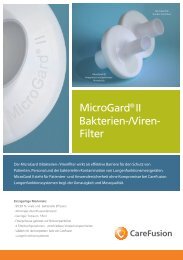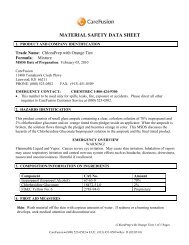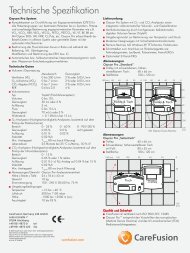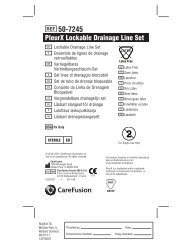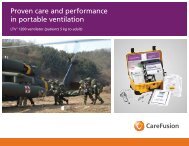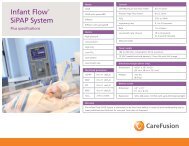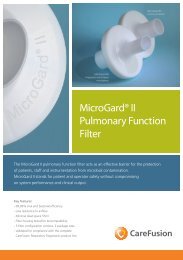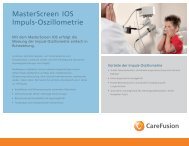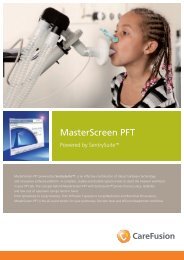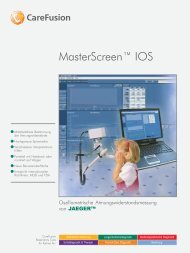PleurX drainage FAQs - CareFusion
PleurX drainage FAQs - CareFusion
PleurX drainage FAQs - CareFusion
Create successful ePaper yourself
Turn your PDF publications into a flip-book with our unique Google optimized e-Paper software.
<strong>PleurX</strong> ® —Innovative<br />
<strong>drainage</strong> solutions for<br />
compassionate care<br />
The <strong>PleurX</strong> ® system has been designed<br />
to allow you to manage your fluid<br />
accumulation in the comfort of your home.<br />
While you have been trained by your doctor<br />
or nurse in the correct way to use the items<br />
in the <strong>PleurX</strong> ® <strong>drainage</strong> kit, we realize you<br />
may still have some questions.<br />
This brochure should provide you with<br />
answers to the most common questions<br />
about using the <strong>PleurX</strong> ® <strong>drainage</strong> kit. These<br />
questions and answers are also available<br />
in the Directions for Use included with<br />
the <strong>PleurX</strong> ® <strong>drainage</strong> kit. If you have any<br />
problems or additional questions about<br />
draining fluid, please refer to the Directions<br />
for Use or contact your doctor or nurse.<br />
Information is also available for you 24<br />
hours a day, 7 days a week online<br />
at carefusion.com/pleurx.<br />
Website: carefusion.com/pleurx<br />
Email: pleurx-info@carefusion.com<br />
© 2010 <strong>CareFusion</strong> Corporation or one of its subsidiaries. All rights reserved.<br />
<strong>PleurX</strong> is a registered trademark of <strong>CareFusion</strong> Corporation or one of its<br />
subsidiaries. IS1690 (DATE/QTY)<br />
<strong>CareFusion</strong><br />
Waukegan, IL<br />
carefusion.com<br />
Frequently asked<br />
questions<br />
<strong>PleurX</strong> ® <strong>drainage</strong> kit
How often should I drain the fluid from my chest<br />
or abdomen?<br />
You should drain fluid as directed by your doctor,<br />
usually every one to two days. Consult your doctor<br />
before changing the frequency of your <strong>drainage</strong>.<br />
Chest: If you keep your chest fairly free of fluid, you<br />
will be less likely to feel short of breath. You will also<br />
be more likely to permanently stop the fluid from<br />
building up, so the catheter can be removed.<br />
Abdomen: If you drain regularly, you will probably<br />
have less abdominal pressure and discomfort.<br />
Chest: What if I still feel short of breath after I<br />
finish draining?<br />
You should not drain more than 1000mL per<br />
<strong>drainage</strong>. Therefore, you should only use one 1000mL<br />
bottle or two 500mL bottles. Notify your doctor if<br />
you continue to feel short of breath after draining<br />
1000mL of fluid.<br />
How long will the catheter be in my chest<br />
or abdomen?<br />
Chest: The catheter will be in your chest until fluid<br />
stops draining. The amount of time will vary from<br />
patient to patient, anywhere from a few weeks to<br />
several months.<br />
Abdomen: Fluid buildup is not likely to stop in the<br />
abdomen. You may keep the catheter in place as long<br />
as you need it.<br />
When will I know the catheter can be removed?<br />
When you try to drain fluid three times in a row and<br />
each time less than 50mL drains into the bottle, you<br />
should see your doctor to find out if the catheter can<br />
be removed or if it needs to be replaced.<br />
What should I do if the color of the fluid<br />
changes from the usual color?<br />
Any change in the appearance of the fluid should be<br />
reported to your doctor.<br />
What does it mean if the volume of my <strong>drainage</strong><br />
is smaller or if I do not drain any fluid?<br />
There are three reasons this might occur.<br />
1. If you drained normally the last time and your<br />
<strong>drainage</strong> suddenly stops or you cannot drain at all this<br />
time, some debris in the fluid may have clogged the<br />
line to the bottle. Gently squeeze the catheter where<br />
it joins the catheter valve, then gently squeeze the<br />
<strong>drainage</strong> line near the access tip. If <strong>drainage</strong> does not<br />
begin, follow the instructions for changing to another<br />
bottle. If the <strong>drainage</strong> does not start when you use a<br />
second bottle, call your doctor. There may be another<br />
reason you are not draining.<br />
2. If your <strong>drainage</strong> is a little less each time you drain<br />
and the current amount of <strong>drainage</strong> is much smaller<br />
than previously, the fluid may be drying up and it<br />
may be time for the catheter to be removed. Call your<br />
doctor.<br />
3. If the fluid goes away suddenly or if the amount<br />
of <strong>drainage</strong> gradually declines, it is possible that the<br />
catheter may be clogged. Call your doctor.<br />
How will I know if my catheter is infected?<br />
You should contact your doctor immediately if you<br />
believe your catheter is infected. Redness (erythema),<br />
warmth to touch, swelling (edema), fever or <strong>drainage</strong><br />
from around the catheter site may indicate your<br />
catheter is infected. Some redness after insertion is<br />
expected but should not persist.<br />
Can I take a shower with the catheter in place?<br />
Yes, if the self-adhesive dressing from the <strong>drainage</strong><br />
kit is securely attached to your skin, you can get wet.<br />
The self-adhesive dressing is designed to keep fluid<br />
out. Be sure the dressing is completely and securely<br />
attached and the catheter and gauze pads are all<br />
contained underneath it. If the gauze becomes wet<br />
when showering, remove the dressing immediately,<br />
clean and dry the area and apply a new dressing as<br />
instructed in the Directions for Use that came with<br />
the <strong>PleurX</strong> ® <strong>drainage</strong> kit.<br />
What happens if the <strong>PleurX</strong> ® catheter is<br />
accidentally pulled out?<br />
The <strong>PleurX</strong> ® Catheter has a polyester cuff that<br />
is normally under the skin where the catheter is<br />
inserted. This cuff and the sutures located where the<br />
catheter exits your body help keep the catheter in<br />
place. In the very unlikely event the catheter is pulled<br />
out, cover the exit site with a sterile dressing and seek<br />
immediate medical attention.<br />
What happens if the <strong>PleurX</strong> ® catheter is<br />
accidentally cut or damaged?<br />
If the catheter is accidentally cut or damaged,<br />
immediately pinch the catheter closed between your<br />
fingers. Slip the blue emergency slide clamp, included<br />
in every <strong>PleurX</strong> ® <strong>drainage</strong> kit, over the catheter and<br />
push the catheter completely into the small end of<br />
the clamp. This will close the catheter. Notify your<br />
doctor immediately.<br />
When should I reorder supplies?<br />
You should reorder supplies when you have three<br />
<strong>drainage</strong> kits remaining.<br />
How do I reorder supplies?<br />
Contact Edgepark Medical at 800.321.0591<br />
or online at edgepark.com.



